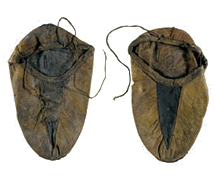|

Seven pairs of moccasins from the McCord Museum of Canadian History
in Montreal were recently treated in CCI's Objects Lab by Ulla Zenz,
a recent conservation graduate from Austria. She was in the middle
of a year-long professional development internship and eager to
investigate and treat North American Aboriginal footwear. Anne MacKay,
the Chief Conservator at the McCord, personally selected and delivered
the moccasins. (Many thanks to Anne!)
Among the beautifully embroidered, beaded, or quilled moccasins
was a flattened pair of sealskin Inuit overshoes. Their beauty came
not from the applied decoration but from the method of construction.
The shoe was made from two pieces of skin. One piece formed the
sole, which was tightly crimped over the toes and stitched to a
narrow V-shaped vamp. On the underside of the shoes, an additional
layer of sealskin was stitched to the toe and heel areas. On top
of these 'clump' soles, strips of skin were sewn in a V-shape at
the heel and in a meandering line at the toe. The clump soles provided
extra insulation and the strips of skin provided traction on hard-packed
snow.
The overshoes were flat, stiff, and somewhat brittle. A fine, white
crystalline material was scattered over much of the exposed surfaces.
Thinking that the deposit might be a toxic material applied decades
ago to prevent insect attack, Ulla went to Jane Sirois of CCI's
Analytical Research Lab with a request to analyse the unknown material.
Jane determined that the white deposit was not toxic, but was puzzled
why magnesium hydrogen phosphate hydrate should be on the overshoes.
After discussions with Anne, Ulla removed as much of the deposit
as was possible using a barely damp cotton swab.
|
 |


|
|
In order to be reshaped, the overshoes were exposed to humid air
(skin absorbs moisture and becomes more flexible). However, the
moist but gentle humidification of the overshoes did little to allow
reshaping. Therefore, a different mode of delivering humid air (which
had worked on other tough skins in the Objects Lab) was used. The
overshoes were wrapped in several layers of a polyester non-woven
fabric, slightly dampened cloths were applied on top, and the overshoes
were placed in plastic bags. Gradually the shoes could be opened
and shaped to resemble their original form.
Ulla designed and made a storage box that would fit into the shelving
space used at the museum. A window in this box provides easy identification,
and the contoured cushioning in the base helps support the multi-layered
soles.
One bit of advice that Ulla passed on to the museum was "Don't
tie the laces. The overshoes are attractive enough without a bow!"
|